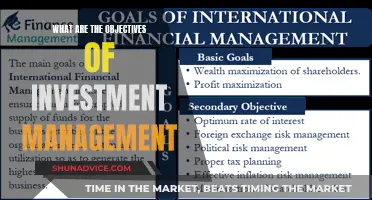
An investment portfolio is a collection of invested assets such as stocks, bonds, mutual funds, and exchange-traded funds. It is a concept that refers to all of your invested assets, which can include investments like stocks, bonds, and funds. Building an investment portfolio can seem intimidating, but there are steps you can take to make the process more manageable. It is important to determine your risk tolerance and time horizon, which will inform how your assets are allocated within your portfolio. You should also choose an account or advisor and select investments that align with your preferences and goals. Additionally, it is crucial to periodically reassess and rebalance your portfolio to ensure it remains aligned with your investment strategy.
| Characteristics | Values |
|---|---|
| Definition | A collection of invested assets |
| Contents | Stocks, bonds, mutual funds, exchange-traded funds, real estate, art, etc. |
| Purpose | To meet future capital requirements and give peace of mind |
| Risk | Depends on the investor's risk tolerance and time horizon |
| Management | Can be managed by the investor or outsourced to a robo-advisor or financial advisor |
| Asset Allocation | Determined by the investor's goals, risk tolerance, age, and financial situation |
| Rebalancing | Periodically reassess and adjust the portfolio to restore its original makeup |
What You'll Learn

Risk tolerance and time horizon
Risk Tolerance
Risk tolerance is the degree of risk that an investor is willing to accept, given the volatility in the value of an investment. It is a crucial component in investing, as it often determines the type and amount of investments that an individual chooses. An investor's risk tolerance is influenced by their age, investment goals, and income.
Those with a higher risk tolerance tend to invest in stocks, equity funds, and exchange-traded funds (ETFs), while those with a lower risk tolerance may prefer bonds, bond funds, and income funds. Aggressive investors, who are willing to risk losing money for the possibility of better results, typically have a higher risk tolerance. On the other hand, conservative investors seek investments with guaranteed returns and are willing to accept little to no volatility in their portfolios.
Time Horizon
The time horizon, or investment time horizon, refers to the period of time one expects to hold an investment until they need the money back. It is largely dictated by investment goals and strategies. For example, saving for a down payment on a house in two years would be considered a short-term time horizon, while saving for retirement would be a long-term time horizon.
The time horizon also influences the level of risk an investor can take. Generally, the longer the time horizon, the more aggressive or risky the portfolio can be, and vice versa. With a longer time horizon, investors have more time to ride out market highs and lows and take advantage of the market's general upward trend.
Short-term investments typically refer to those held for less than five years and are suitable for investors approaching retirement or needing a large sum of cash soon. Medium-term investments are held for three to ten years and are often used for saving for significant purchases or milestones. Long-term investments are those held for ten or more years and are usually for retirement savings.
Understanding risk tolerance and time horizon is essential for building a well-informed and tailored investment portfolio. By considering these factors, investors can make more informed decisions about the types of investments to include in their portfolios and how to allocate their assets.
Savings and Investments: Keys to Economic Growth
You may want to see also

Investment portfolio definition
An investment portfolio is a collection of assets that can include stocks, bonds, mutual funds, and exchange-traded funds (ETFs). It is a concept that brings together all your invested assets under one metaphorical roof. For example, if you have a 401(k), an individual retirement account, and a taxable brokerage account, you should consider them collectively when deciding how to invest.
Your risk tolerance and time horizon are crucial factors in determining how your assets are allocated within your portfolio. Risk tolerance refers to your ability to accept investment losses while seeking higher investment returns. It is influenced by your personality, how much time you have before your financial goal, and how you mentally handle market fluctuations. The time horizon, on the other hand, refers to the length of time you plan to hold your investments before selling them.
When building an investment portfolio, it is essential to determine your appropriate asset allocation, choose the right account or advisor, select investments that align with your preferences and goals, and periodically reassess and rebalance your portfolio.
Types of Investments
- Stocks: Stocks represent a tiny slice of ownership in a company. Investors buy stocks expecting them to increase in value over time. However, there is a risk that the stock might not appreciate or might even lose value. To mitigate this risk, many investors opt for funds such as index funds, mutual funds, or exchange-traded funds (ETFs) that hold a diverse collection of stocks from various companies.
- Bonds: Bonds are loans made to companies or governments, which are repaid over time with interest. They are considered safer investments than stocks but typically offer lower returns. Bonds are known as fixed-income investments because the interest rate is predetermined.
- Mutual Funds: Mutual funds allow investors to hold a basket of securities, such as stocks or bonds, providing instant diversification to their portfolio. While some mutual funds are actively managed by fund managers, others are passively managed, mirroring an established index (index funds). Mutual funds usually have higher fees than ETFs due to the active management involved.
- Exchange-Traded Funds (ETFs): ETFs are similar to mutual funds but trade like stocks. They offer cost savings compared to mutual funds while still providing diversification. ETFs are not actively managed but track a chosen index or basket of stocks, making them a passively managed investment option.
Strategies to Optimize Your Investment Portfolio for Maximum Returns
You may want to see also

Investment portfolios and risk tolerance
Risk tolerance is a crucial aspect of investment portfolios, determining the types and amounts of investments an individual chooses. It refers to the degree of risk an investor is willing to take on, given the potential for gains or losses in the value of their investments.
When constructing an investment portfolio, it is essential to consider your risk tolerance and time horizon. Your risk tolerance is influenced by factors such as your age, investment goals, income, and mental comfort with market fluctuations. If you have a low-risk tolerance, you may prefer investments with guaranteed returns, such as bonds, bond funds, income funds, or bank certificates of deposit (CDs). On the other hand, if you have a high-risk tolerance, you may be open to investing in stocks, equity funds, and exchange-traded funds (ETFs), which offer the potential for higher returns but also carry greater risk.
It's important to note that risk tolerance can change over time as your financial situation, goals, and comfort level evolve. For example, a young investor just starting their career may have a higher risk tolerance, while someone nearing retirement may have a more conservative approach to avoid potential losses.
To build an effective investment portfolio, you should first determine your risk tolerance and investment goals. This will help you choose the right mix of assets, such as stocks, bonds, mutual funds, and ETFs, to align with your risk tolerance and desired level of diversification. It's also crucial to monitor and rebalance your portfolio periodically to ensure it remains aligned with your risk tolerance and investment strategy.
Additionally, it's worth mentioning that risk tolerance assessments are available online through questionnaires and surveys, which can provide valuable insights into your comfort level with investment risk.
Strategies for Taking Control of Your Investment Portfolio
You may want to see also

How to build an investment portfolio
Building an investment portfolio can be a challenging task, but it doesn't have to be complicated. Here are some steps to help you create and maintain a successful investment portfolio:
Define your goals and time horizon:
Start by making a list of your financial goals and sorting them by time horizon. Decide how much time you have to achieve each goal, whether it's short-term (within a year), medium-term (1-5 years), or long-term (more than 5 years). This will help you determine the level of risk you're comfortable with and the types of investments that align with your goals.
Understand your risk tolerance:
Your risk tolerance is your ability to accept potential losses in pursuit of higher investment returns. Consider your personality and how you handle market volatility. Are you comfortable with potential short-term losses for the possibility of greater returns? Your risk tolerance, along with your time horizon, will guide your investment strategy.
Choose the right account:
Select an investment account that aligns with your goals. Tax-advantaged accounts like IRAs and 401(k)s are suitable for long-term, retirement goals, while taxable brokerage accounts are better for mid- to long-term goals. For short-term goals, consider low-risk deposit accounts like high-yield savings accounts.
Select your investments:
Now, it's time to choose the actual assets you want to invest in. This includes stocks, bonds, mutual funds, exchange-traded funds (ETFs), real estate, cryptocurrencies, and more. Diversify your portfolio by investing in different asset classes and sectors. You can also consider alternative investments like precious metals, commodities, or hedge funds, but be aware that these often carry higher risks.
Determine your asset allocation:
Decide how much of each asset class you want in your portfolio. Consider your risk tolerance and investment goals when determining your allocation. For example, a higher-risk investor might allocate 90% to stocks and 10% to bonds, while a moderate-risk investor might choose a 60/40 split. Diversify within each asset class by investing in multiple sectors, such as healthcare, technology, and industrials.
Monitor and rebalance:
Your investment portfolio requires ongoing care and attention. Regularly monitor your portfolio to ensure it aligns with your goals and risk tolerance. Rebalance your holdings if the market becomes volatile or if your initial weightings change over time. You may also need to adjust your strategy as your life circumstances change, such as getting married, having children, or nearing retirement.
Savings Investment Strategies: Accessibility and Growth
You may want to see also

Avoid risky products and behaviours
An investment portfolio is a collection of invested assets, such as stocks, bonds, funds, and real estate. When building an investment portfolio, it's important to consider your risk tolerance and time horizon to ensure your investments align with your financial goals and personality. Here are some strategies to avoid risky products and behaviours when creating your personal investment portfolio:
- Know your risk tolerance: The first step in constructing a portfolio is understanding your financial situation, goals, and risk tolerance. Ask yourself how much risk you can bear and how you handle market volatility. If you can't sleep at night due to short-term drops in your investments, then more stable and conservative investments may be a better fit.
- Diversify your portfolio: Diversification is a key strategy to reduce risk. By investing in a variety of assets and across different industries, you can lower the impact of any single investment or industry on your portfolio. Consider investing in a mix of stocks, bonds, mutual funds, exchange-traded funds (ETFs), and other asset classes.
- Choose stable and reliable investments: Opt for investments that have a track record of stability and reliable returns. This could include blue-chip companies that pay dividends, government bonds, or other fixed-income securities. These types of investments may provide more consistent returns and protect your principal.
- Avoid speculative investments: Stay away from speculative investments such as cryptocurrencies and options trading. These are often risky and are more akin to gambling than investing. Instead, focus on investments with inherent value, such as stocks, real estate, or bonds.
- Monitor and rebalance your portfolio: Regularly assess and rebalance your portfolio to ensure it aligns with your risk tolerance and financial goals. Over time, the value of your investments may change, affecting your initial weightings. By periodically rebalancing, you can maintain your desired level of risk and ensure your portfolio stays on track.
- Consider dollar-cost averaging: This strategy involves investing a fixed amount of money into the same investment vehicle(s) at regular intervals, regardless of market performance. This approach helps to systematically build wealth and diversify the prices at which you buy shares. It can also help remove emotions from your investment decisions, reducing the potential for impulsive choices.
- Seek professional advice: Consult a financial advisor or a robo-advisor to gain personalized advice based on your unique circumstances. They can help you build a portfolio that aligns with your risk tolerance and financial goals, providing guidance and support along the way.
Savings and Investments: Smart Money Strategies for Beginners
You may want to see also
Frequently asked questions
A personal investment portfolio is a collection of your invested assets, such as stocks, bonds, mutual funds, and exchange-traded funds (ETFs). It is a concept that helps you view all your assets under one metaphorical roof.
A personal investment portfolio allows you to diversify your investments, mitigate risks, and potentially achieve long-term growth. It also enables you to make informed decisions about your financial future and plan for retirement.
The first step is to determine your financial goals and risk tolerance. Consider your age, time horizon, capital, income needs, and personality. Once you have a clear understanding of your financial situation, you can start allocating your assets accordingly.
You can include a variety of assets such as stocks, bonds, mutual funds, exchange-traded funds (ETFs), real estate, and even alternative investments like art or cryptocurrency. Diversification is key to a well-balanced portfolio.
It is important to regularly monitor and rebalance your portfolio. Reassess your weightings, consider tax implications, and make adjustments as needed to ensure your asset allocation aligns with your financial goals and risk tolerance. Seeking advice from a financial advisor or using a robo-advisor can also help you optimize your portfolio.







